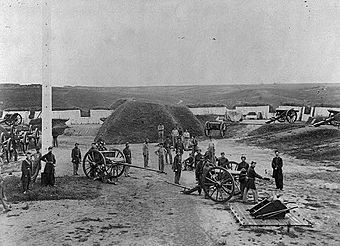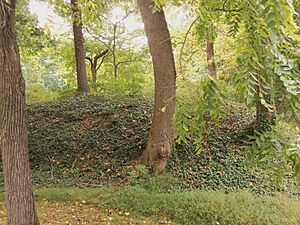Fort C. F. Smith (Arlington, Virginia) facts for kids
|
Fort C. F. Smith Historic District
|
|

Part of the lunette's earthworks are on the right.
|
|
| Location | 2411 24th St., Arlington, Virginia |
|---|---|
| Area | 19 acres (7.7 ha) |
| Built | 1863 |
| NRHP reference No. | 99001719 |
Quick facts for kids Significant dates |
|
| Added to NRHP | February 1, 2000 |
Fort C.F. Smith was a special type of fort called a lunette. It was built by the Union Army in 1863. This happened during the American Civil War in what is now Arlington County, Virginia.
The fort was named after General Charles Ferguson Smith. He was a Union Army general who passed away in 1862. Fort C.F. Smith was part of a line of forts called the Arlington Line. These forts helped protect Washington, D.C., the capital of the United States, from attacks by the Confederate States Army.
The Army built the fort on a high hill overlooking the Potomac River. It also overlooked a stream called Spout Run. Because of its high spot, the fort could protect the Aqueduct Bridge. This bridge was important for travel across the river.
Contents
History of Fort C.F. Smith
Building the Fort During the Civil War
After the Union Army lost a big battle in August 1862, they decided to build more forts. Fort C.F. Smith was built in 1863. It was built on land that used to belong to a person named Thomas Jewell. There was a red house on the property, so the fort was sometimes called "Fort at Red House." The Army had to tear down the house to build the fort.
The fort was shaped like a crescent moon and had strong walls made of earth. It was designed to hold 22 cannons. General John G. Barnard said the fort was "carefully planned and constructed." It had special parts to protect it from attacks, even from ravines near the river.
Life at the Fort During the War
In May 1864, a report showed what was inside Fort C.F. Smith. It had about 550 soldiers and many different types of cannons. These included field howitzers, siege guns, and mortars.
The fort also had two magazines for storing ammunition. These were kept dry and ready to use. Soldiers at the fort practiced their artillery and infantry drills.
Even though the fort was ready for battle, it didn't see much fighting. The biggest dangers for the soldiers were diseases like malaria and typhoid fever. They also had to be careful when handling live ammunition.
After the War Ended
When the Civil War ended in April 1865, Fort C.F. Smith was taken apart. The Army removed the wooden parts and sold them. They also destroyed the fort's magazines and bomb-proof areas. A bomb-proof was a strong shelter that protected soldiers from enemy shells.
The land where the fort stood was returned to Thomas Jewell's family. Over the years, different families owned the property. In 1965, a historical marker was placed near the fort's remains.
In 1987, the local government made the fort a local historic district. Then, in 1994, the county government bought the land. They turned it into the 19-acre Fort C.F. Smith Park. This helped save the fort's remains.
In 2000, the fort was added to the National Register of Historic Places. This is a list of important historical sites in the United States. Today, you can visit the park and see parts of the old fort.
Existing Remnants Today
Most of the original earthen walls of Fort C.F. Smith are still there. You can see them in Arlington County's Fort C.F. Smith Park. Some parts were removed when a road was built, but much of it remains.
You can clearly see where gun platforms 8 through 11 once stood. There is also a well that soldiers used. The fort has unusual bastions, which are parts of the fort that stick out. These bastions helped soldiers fire at attackers from different angles.
The old ammunition magazine and the bomb-proof area are also still visible. Soldiers would hide in the bomb-proof if the fort was under attack. It also acted as a traverse, which helped limit damage from shell explosions. You can also see the Parapets, which were low walls that protected soldiers. The gorge, which protected soldiers from attacks from the side, is also still there.
Images for kids






